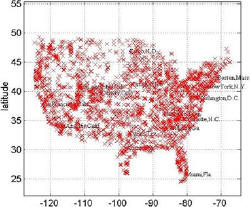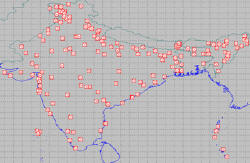First a few words about India. India is called the “Crouching Tiger” for a very good reason - it is becoming a global competitor. India has the second fastest growing major economy in the world, with a GDP growth rate of 8.1% (China’s GDP is 10%). Goldman Sachs predicts that by 2020 India will have developed one of the world’s largest economies. The Indian economy is surging. Its gross domestic product has more than doubled in fifteen years, from $317 billion in 1990 to $650 billion in 2004. India currently commands 44% of the global market for IT and business process outsourcing off-shore. The (Internet) IT industry, which barely existed in 1991, now employs more than 1 million people and generated revenue of $36 billion in 2005 (expected to hit $56 billion in 2007.) India has a very high level of entrepreneurial activity (second highest in the world according to Babson’s Global Entrepreneurship Monitor). India has recently been prominent in the news as a provider of outsourcing services and software. It has the fastest growing market for telecom equipment. Moreover, India is the world’s most populous democracy, with 1.1 billion people, and still one of the poorest. But, India has 300 million new middle class consumers – that’s the size of the US or European market!
I had the privilege to present my book, Local Positioning Systems, and talk about positioning technologies both alternative and complimentary to GPS. These technologies include TV-positioning from Rosum (which works by means of triangulating signals from TV towers giving a 10m accuracy indoors and outdoors with the Rosum HPM) and Wi-Fi positioning, such as Mexens’ Navizon (which works by means of triangulating Wi-Fi + GSM/CDMA; GPS is optional). The figures below show that TV infrastructure is highly correlated with centers of population and commerce, both in the US and India.
 |
Indian GPS and Telematics Market Overview
As of 2006, the global market for GPS devices is US $2.3 billion. Major players in the GPS industry include Rockwell, Trimble, Leica Geosystems, SiRF and CSI Wireless. GPS’ overall production value globally is expected to grow to more than $30 billion in 2008, up from $13 billion in 2003. The volume of the GPS market was assessed at $22 billion in 2005. In the US, the GPS chipset market is expected to grow to more than 200 million units per year by 2007.
The Indian market is now at $22 million, but there is potential for growth to $448 million in the next three to four years. GPS companies (both local and international) are competing to grab a piece of this Indian market, especially in logistics for tracking cargo and trucks across the country. Prices for GPS devices in India range from $232 to over $2,325. Garmin will bring its 35 different models of GPS devices to India, ranging from $813 for a basic model to $2,325 for a high-end model (route planning with voice prompts). Local company SatNav launched SatGuide, a car navigation device, and is hoping to sell 3,000 units in the first year. This Pocket PC-based device (costing $883) has maps for 10 major Indian cities. Other companies like Sun Micro Systems (India) are building prototypes to provide location-based services for mobile roaming users. Wipro has developed GPS applications for clients such as those in fleet management, location-based services and automatic driver assistance.
One of the highlights of the conference was the announcement that the Indian government has allocated $250 million for GPS activities and to launch eight or more satellites by 2009. Overall, India’s steps towards GPS presence include the following activities:
- GAGAN (for aviation navigation; there are 400 airports in India)
- GSAT
- Cooperation with GLONASS
- Participating in Galileo (the U.S. maintains that the equipment manufacturers need to participate freely in the market)
- Development of a down stream and value added industry (i.e., development of receivers, software, etc.)
- Indo-US initiatives such as:
- Joint development partnership for precision receivers
- Promoting growth of domestic LBS market
- Developing sensitivity and knowledge based on interference to signals
The Indian telematics market is also in an introductory stage. System integrators have been offering vehicle tracking and fleet management systems since 2001. During 2004, demand for these systems increased, largely due to purchases by logistics companies and other fleet operators. In 2005, navigation systems were launched in India for the first time by system integrators. The vehicle tracking segment of the Indian telematics market is expected to reach around $35 million between 2008 and 2009. To support telematics growth in India the government needs to decrease the restrictions on the availability of digital maps for commercial usage. Global companies are working with Indian companies by outsourcing their requirements for developing GPS components, embedded software and other telematics-related systems and designs. SiRF has acquired ImpulseSoft in a cash-and-stock deal worth Rs 67.5 crore (or $675 million). ImpulseSoft provides Bluetooth solutions for the automotive and consumer market in India. SiRF also has a new development center in India, built in 2004, which produces technical collateral and reference designs to accelerate time to market for customers, and funds research in location technology at Indian educational and research institutions.
GPS Phone Cost in India
This topic created a hot debate during one of the panel sessions. The question was asked (by the ministry of communication), why GPS-enabled cell phones are so expensive in India, with the result that the general public cannot afford them. A phone in India costs $20. A GPS phone costs $40 extra, for a total of $60. This extra cost prevents GPS-enabled phones from penetrating the Indian market. (US reference: $5 to $10 extra for GPS chip for phones.) Taxes and duties in India add about 65% to the landed cost. Moreover, the cost of transportation/marketing increases when the product comes to India from abroad. So the end user has to pay a very high price compared with his U.S. counterpart. Plus, every GPS import needs a license from the Indian government. These licenses are obtained by the vendors on behalf of the user. This is a cumbersome process and takes at least 2 to 4 months or more. This also helps to further escalate the cost of GPS indirectly. Nevertheless, the GPS vendors in India understand that they need to provide simple, low cost and reliable GPS solutions in order to penetrate the market.
The panel was composed of GPS/Gailelo experts and advocates who continually praised GPS. Also on the panel were executives from companies like NavCom, who praised their own StarFire GPS ground-based augmentation product’s 1-2cm positioning accuracy (the cost of the StarFire system was not disclosed). It was interesting to hear a comment from the audience addressed to the panel, saying that the 1-2m accuracy that comes with the expensive GPS augmentation equipment is highly specialized and does not apply to the cell phone market.
Also of note - A-GPS service is non-existent in countries like India. India could use an E911-/E112-like mandate from the government, which proved to be so effective in the US and Europe, that would grow the positioning infrastructure.
The Future with Galileo and other GNSS systems
The conference had a heavy focus on GNSS and GPS technologies. New satellite navigation systems - the European Union’s Galileo, Russia’s GLONASS, Japan’s Quasi-Zenith Satellite System, and China’s Twinstar - are going up. The speakers talked about the use of GNSS and of various augmentation systems in use and those which are being planned. One of the main goals of the community is GPS and Galileo interoperability, which is expected to happen thanks to Galileo’s E5a signal complementing the L1 signal of the GPS. Also, it is imperative that there must be a Galileo standard for use with mobile phone services (GSM & CDMA technology).
The range of Galileo services is designed to meet practical objectives and expectations, improving the coverage of open access services in urban environments (to cover 95% of urban districts compared with the 50% currently covered by GPS alone). In the GPS/Galileo/GNSS system there will be 56-60 satellites present, so the availability of the signal will be better, as compared to the signals of a single system. Devices which will make use of both GPS and Galileo (probably not cell phones due to chip cost) are expected to improve positioning accuracy up to 10 cm.
Relating to indoor coverage, the Galileo E5a signal is expected to allow better acquisition and tracking performance. Better signal availability for indoor applications can be achieved by the augmentation (which is somewhat expensive) of locally generated signals with the satellite signals. These local signals will provide additional performance in terms of accuracy, availability, continuity and integrity. Also, the presence of local pseudolites will enhance vertical accuracy in indoor positioning. Pseudolites are hi-performance products for professional use and could not, generally, be affordable for end-user market penetration.
GPS pseudolites and augmentation solutions tend to be very specialized and expensive, something not applicable to the LBS cell phone market. However, this is an area that needs further investigation. Some pseudolite-based navigation systems activities include the following:
- Presently USA, Japan, Australia, Germany, China and Canada are involved in the development of pseudolite-based navigation systems.
- Japan has been investigating an airship system for applications such as environmental monitoring, communication and broadcasting.
- In India, IIT- Bombay, Osmania University and DRDO have been working in this area.
Conclusion
The GPS and telematics market in India are in an introductory stage, but are developing rapidly owing to an increased use of the technology in fleet management, transport navigational systems, and other areas. In India, system integrators have been offering vehicle tracking and fleet management systems since 2001. Similarly, personal GPS navigation guides have been offered since 2001, starting with GPS India’s iQue 3600 PDA for about $1,500. During 2004, demand for the vehicle tracking systems increased, largely due to purchases by logistics companies and other fleet operators.
According to Frost & Sullivan, vehicle tracking systems sales in India are expected to increase with growing awareness, exponential growth in new commercial vehicle sales, and penetration into the market. The vehicle tracking segment of the Indian telematics market is expected to reach around $35 million between 2008 and 2009.
India has long supplied hardware and software engineers to U.S. industry. Now the country has taken an active partner role in Europe's GALILEO navsat program, not to mention the development of its own satellite system. Watch out for the “Crouching Tiger” - it is set to pounce!
